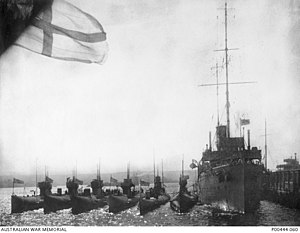This article needs additional citations for verification. (May 2010) |
 HMAS Platypus with all six Australian J-class submarines in 1919
| |
| History | |
|---|---|
| Builder | John Brown and Company, Clydebank, Scotland |
| Laid down | 14 October 1914 |
| Launched | 28 October 1916 |
| Commissioned | 21 March 1917 |
| Decommissioned | 1919 |
| Fate | Transferred to Royal Australian Navy |
| Commissioned | 25 March 1919 |
| Decommissioned |
|
| Renamed |
|
| Reclassified |
|
| Stricken | 20 February 1958 |
| Motto | "Nothing Too Difficult" |
| Honours and awards |
|
| Fate | Sold for scrap in 1958 |
| General characteristics | |
| Displacement | 3,476 tons |
| Length |
|
| Beam | 44 ft (13 m) |
| Draught | 15 ft 8 in (4.78 m) |
| Propulsion | 2 sets of triple expansion reciprocating steam engines, twin screw |
| Speed | 15.5 knots (28.7 km/h; 17.8 mph) |
| Armament | 1 × 4.7-inch gun |
HMAS Platypus was a submarine depot ship and base ship operated by the Royal Australian Navy (RAN) between 1919 and 1946. Ordered prior to World War I to support the Australian submarines AE1 and AE2, Platypus was not completed until after both submarines had been lost, and she was commissioned into the Royal Navy from 1917 to 1919.
After the RAN acquired six J-class submarines, Platypus was recommissioned as an Australian warship. She was repurposed as a destroyer tender after the J class was removed from service in the 1920s, tasked with supporting the two O-class submarines during 1929 and 1930. After the submarines were placed in reserve, Platypus was renamed HMAS Penguin and operated as a depot ship until 1941. The ship assumed her old name and was relocated to Darwin, then Cairns for use as a base ship. After a refit in 1944, Platypus operated as a repair vessel in New Guinea waters until she was placed into reserve in 1946. Platypus was sold for scrap in 1958.